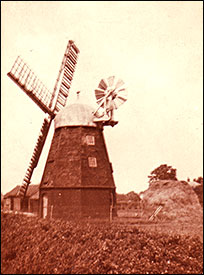|
A few yards from the Bedfordshire border, on the eastern side of the Wymington road stands the converted ground floor base of the county's last remaining smock mill. The eight-sided single storey building is painted white and has a tiled octahedral roof complete with a chimney stack. Large extensions have been added which disguise the base somewhat, but the name 'Mill Estate' confirms its former use.
 |
|
The Old Mill from a postcard
|
The Wymington Road windmill, which is frequently but incorrectly referred to as 'Wymington' windmill, appears on Bryant's 1824 map standing beside a bridle-way. It was a superficially conventional smock mill with an octagonal horizontally boarded wooden tower, dome cap (with finial) and four sails. Other features included an eight-bladed fantail and a luffing wheel. Unusual was the protection applied to the weatherboarding of the two storey smock tower which consisted of a covering of tarred felt. This differed from the system employed at Northamptonshire's only other smock mill at Eye Green where the tower was clad in triple weatherboarding. Rushden mill's sails, too, deserve special mention, for not only did they revolve in a clockwise direction, but comprised two common sweeps and two spring. As in the cases of Barnack post mill and Kingsthorpe tower mill in Northampton the shutters were operated by levers at the sail's tip, and the springs were contained in boxes fitted to the centre of the whips.
George Judkins Aychurch was described as a miller and baker in Rushden around 1838. He almost certainly worked the Wymington Road smock mill because one Mr A. Aychurch did so in the mid-1840s. At this time the mill was copyhold to the noted Sartoris family of Rushden Hall, who probably employed subsequent millers including Mr T. Moore between 1854 and in the early 1870s, Stephen Hall and possibly George Walker.
In the years preceding World War I the smock mill belonged to Mr and Mrs Lewis. The miller in 1903 was William Chapman who, within three years, was replaced by William Laurance. The latter undertook much of his own millwrighting, including dressing the stones. But Mr Laurance was not without help. Two young assistants, Frederick Dilley and his younger brother William helped Mr Laurance with the odd-jobs about the windmill, including setting the cloth and shuttered sails, and delivering the flour. When interviewed in 1980 at the advanced age of 81 William recalled that it was not unusual for Mr Laurance to lodge with the Dilley family but this did not stop a young William from being chastised by the miller after being caught
swinging from the fan cradle during a spell of boisterous horseplay. Mr Dilley remembered that during the mill's time it processed a variety of foodstuffs, including flour, kibling beans and bran. Towards the end of its life this principally would have been for livestock when wartime legislation forbade the selling of stone-ground flour for human consumption. Meanwhile, the Great War had taken its toll, soon after joining up, Frederick was killed during the bitter fighting in France, and William spent his sixteenth birthday in the trenches. William Laurance, however, found romance during those dark years, married and later left the district. After that, in about 1915, the windmill stopped working forever.
The windmill remained standing but disused until around 1920 when the sails and machinery were removed and the wooden tower dismantled. The base was converted and put up for sale by Mrs Lewis for £300. It was bought by William and Frederick's elder brother, John H. Dilley, and at a cost of £400 a roof was added by Messrs Farrows of Rushden. William Dilley had also married, and was living close by at the mill house which was known locally as the 'Red House' and stood adjacent to the base.
All of John Dilley's three children were born in the windmill's base. His youngest daughter is related to the current owner who acquired the property in 1963. Soon afterwards the building was renovated, and extensions were added after it was found that the base only measured 22 feet across, and proved to be very cramped. Although proud of his home, the owner told me that members of the public can prove to be something of a nuisance once discovering the house was part of a windmill. Hopefully readers will bear this in mind.
|